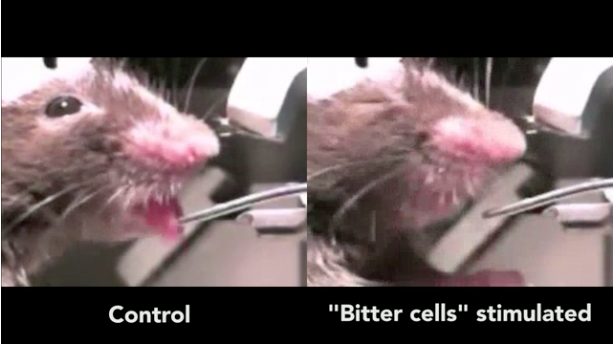|
|||||||||||||||
|

CLICK ON weeks 0 - 40 and follow along every 2 weeks of fetal development
|
||||||||||||||||||||||||||||
|
Turning taste on and off in the brain Most people probably think that we perceive the five basic tastes — sweet, sour, salty, bitter and umami (savory) — with our tongue, which sends signals to our brain "telling" us what we've tasted. However, scientists have turned this idea on its head, demonstrating in mice that they can change the way something tastes by manipulating groups of cells in the brain. The findings were published in the online edition of Nature.
The primary aim of Dr. Zuker's lab is to understand how the brain transforms chemical stimuli into perception. Over the past decade, Dr. Zuker and colleagues have proved there are dedicated receptors for each taste on the tongue, and that each class of receptor sends a specific signal to the brain. More recently, they demonstrated each taste is sensed by unique sets of brain cells, in separate locations in the brain's cortex — generating a map of taste perception in the brain. The scientists used optogenetics, allowing them to directly activate specific neurons with laser light. Yueqing Peng, a postdoctoral associate in Dr. Zuker's lab, examined whether manipulating neurons in these regions could evoke perception of sweet or bitter, without the mouse actually tasting either. Sweet and bitter were chosen because they are the most critical tastes for animals, including ourselves. Sweet taste identifies energy-rich nutrients, while bitter warns against potentially noxious chemicals. Zucker: "In this study, we wanted to know if specific regions in the brain really represent sweet and bitter. If they do, silencing these regions would prevent the animal from tasting either, no matter how much we gave them. And if we activate these fields, they should taste bitter or sweet, even though they're only getting plain water." Which is exactly what they observed. When scientists injected a substance into the mice to silence sweet neurons, the animals could not reliably identify sweet. They could, however, still detect bitter. The animals regained their ability to taste sweet when the drug was flushed from their brain. Conversely, silencing the bitter neurons prevented the mice from recognizing bitter, but they could still taste sweet. Remarkably, researchers were also able to convince animals they were tasting bitter or sweet, even when drinking only water. During drinking, when researchers activated the sweet neurons they observed behaviors such as greatly increased licking. In contrast, stimulating bitter neurons dramatically suppressed licking, and elicited taste-rejection responses, including gagging. The researchers also performed optogenetic tests on animals that had never tasted sweet or bitter chemicals, and showed activation of corresponding neurons triggered the appropriate behavioral response.
In a final set of experiments, animals were trained to report the identity of an oral sweet or bitter taste by performing a task. In the experiments, mice tasted bitter, sweet and salty chemicals sometimes, but at other times researchers activated laser lights to stimulate an animals' sweet or bitter cortical brain field. Abstract The paper is titled, "Sweet and bitter taste in the brain of awake behaving animals." The other contributors are Yueqing Peng (CUMC), Sarah Gillis-Smith (CUMC), Hao Jin (CUMC), Dimitri Tränkner (CUMC and Howard Hughes Medical Institute, Asburn, Va.), and Nicholas J. P. Ryba (National Institute of Dental and Craniofacial Research, National Institutes of Health, Bethesda, Md.). The study was supported by grants from the National Institute of Drug Abuse (DA035025) and the Intramural Research Program of the National Institutes of Health and the National Institute of Dental and Craniofacial Research. The researchers declare no financial or other conflicts of interest. Columbia University Medical Center provides international leadership in basic, preclinical, and clinical research; medical and health sciences education; and patient care. The medical center trains future leaders and includes the dedicated work of many physicians, scientists, public health professionals, dentists, and nurses at the College of Physicians and Surgeons, the Mailman School of Public Health, the College of Dental Medicine, the School of Nursing, the biomedical departments of the Graduate School of Arts and Sciences, and allied research centers and institutions. Columbia University Medical Center is home to the largest medical research enterprise in New York City and State and one of the largest faculty medical practices in the Northeast. For more information, visit cumc.columbia.edu or columbiadoctors.org. |
Nov 24, 2015 Fetal Timeline Maternal Timeline News News Archive
|
||||||||||||||||||||||||||||


